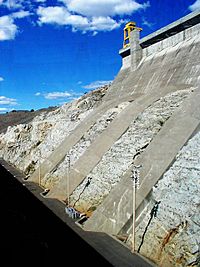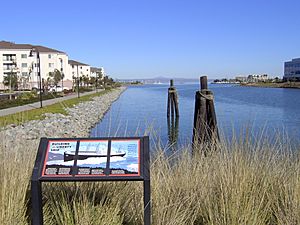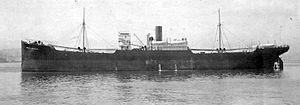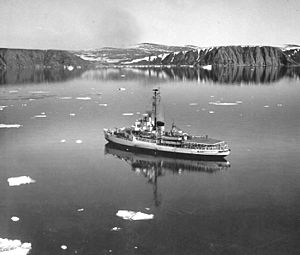Western Pipe and Steel Company facts for kids
| Industry | Manufacturing & shipbuilding |
|---|---|
| Fate | Liquidated |
| Founded | c. 1907 |
| Defunct | 1945 |
| Headquarters |
,
United States
|
| Products | Ships, iron and steel products |
| Services | Ship repair |
The Western Pipe and Steel Company (WPS) was an American company. It was known for building ships during World War II for the United States Maritime Commission. They also built ships for the U.S. Shipping Board in World War I. In the 1930s, WPS helped build the huge Grand Coulee Dam.
Contents
Early Beginnings of Western Pipe & Steel
The company started in Los Angeles, California around 1907. Two brothers named Talbot and a partner, T. A. Hays, likely founded it. Hays had 21 years of experience in the steel industry. He became the Vice President of the new company. At first, WPS made small steel pipes and metal casings. James A. Talbot, who later became rich and then lost his money with the Richfield Oil Company, was an early President.
Western Pipe & Steel quickly grew. In 1910, they opened a factory in Taft, California. This factory supplied pipes and containers to the oil industry. Another factory opened in Fresno in 1913. In 1915, a third new factory started in Phoenix, Arizona. It served farms and the oil industry there.
The company moved into San Francisco in 1910. They bought a local pipe maker called Francis Smith Company. This company had been around since 1854. Soon after, WPS bought land in the Richmond District of San Francisco. They moved the Francis Smith plant to this new spot.
Building Ships in World War I
In 1917, Western Pipe & Steel bought another San Francisco company, Schaw Batcher Pipe Works. Schaw Batcher was located on San Francisco Bay. It had just won a contract from the U.S. Shipping Board. This contract was to build 22 merchant ships. The Shipping Board wanted to create a strong navy support and merchant marine fleet. By buying Schaw Batcher, Western Pipe & Steel got these contracts. This was their first step into building ships.
The contract asked WPS to build eighteen ships of about 5,650 tons each. They also had to build four larger ships of 8,800 tons. The larger ships were canceled in 1918. But all eighteen smaller ships were finished. Few were ready in time to serve in the war. All these ships were built with rivets, which was the common method then. They were 410 feet (120 m) long and 54 feet (16 m) wide. They had a draft of 24 feet 2 inches (7.37 m) and weighed about 8,000 tons. They used oil fuel and could go 11 knots (20 km/h). Each ship had a crew of 39 to 45 people.
The company needed more space near the water. So, they dug a large rectangular launching basin. They built four shipping ways, two on each side. Ships were launched sideways into the basin. This method was not perfect for big ships. Some ships were damaged when launched and needed repairs. However, the company kept using side launching. They eventually solved these technical issues. The channel and shipping ways were built in just three months. The first ship, Isanti, started being built on November 30, 1917.
The first eight ships had General Electric steam turbines. These engines were not very reliable and often broke down. Some of these ships were lost at sea because of engine problems. The rest were scrapped by 1930.
The other 10 ships used triple expansion engines. These were built by Joshua Hendy Iron Works, a local San Francisco company. The 2,800 horsepower (2,100 kW) Joshua Hendy engines were much more dependable. Many ships with these engines had long careers. One ship, the West Camargo, served for almost 60 years. It was scrapped in the late 1970s. None of these ships were lost in World War I. But more than half of the nine that served in World War II were sunk by enemy action.
Ships Built (1918-1920)
| Ship type | No. Built | Delivery date | Displacement (tons) | |||
|---|---|---|---|---|---|---|
| First | Last | Light | Full | Total | ||
| Cargo ship | 18 | 10/18 | 10/20 | 5,650 | 8,000~ | 101,700 |
Between the Wars: Growth and Big Projects
Many shipyards that opened for World War I closed after the war. But Western Pipe & Steel kept growing. In 1921, the company closed its Richmond site. It moved that plant to the San Francisco shipyard. This shipyard then started building barges and pipes. During this time, the company built fuel, gasoline, and water barges. They also made covered lighters. The exact number is not known. But company records suggest they built up to 34 such vessels between the wars.
WPS also expanded to other areas. The Fresno factory grew. In the 1930s, new operations started in the San Francisco peninsula. They also opened sites at Grand Coulee and Seattle.
Building the Grand Coulee Dam Pipes

One of Western Pipe & Steel's biggest jobs during peacetime was for the Grand Coulee Dam. This dam was built in the 1930s. It was planned to be the largest hydroelectric power plant in the United States. Many companies worked on this huge project. Western Pipe & Steel won the contract to build the dam's penstock and pump inlet pipes. These pipes were so big they couldn't be moved to the site. So, they had to be made right there in a special factory built for them.
The first 18 penstock pipes were each 290 feet (88 m) long and 18 feet (5.5 m) wide. The last three were the same length but 6-foot (1.8 m) wide. The twelve pump-inlet pipes were each 14 feet (4.3 m) wide. Making these pipes needed over nine miles (14 km) of heavy welds. This work helped Western Pipe & Steel become a world leader in automated welding by World War II. This skill was very useful for their wartime shipbuilding.
Hetch Hetchy Pipeline Project
Another big project for Western Pipe & Steel was building water pipes. These pipes carried water from the O'Shaughnessy Dam in the Hetch Hetchy Valley. They went to the Crystal Springs Reservoir near San Francisco. Today, this dam supplies water to 2.4 million people in San Francisco. The company also worked on a pipeline for Everett, Washington.
Western Pipe & Steel in World War II
In the late 1930s, the U.S. government created the Maritime Commission. Its job was to replace America's old merchant ships. They wanted new, modern ships that could help the navy if there was a war. In 1937, the commission started a plan to build 500 new merchant ships over ten years.
Western Pipe & Steel was in a good position when the commission offered contracts. The company's President, H. G. Tallerday, had connections in the government. Also, the company had years of experience with heavy welding from the 1930s. This meant they were one of only three companies on the west coast that could immediately build ships with all-welded hulls. The company was ranked 89th among U.S. companies for its value in World War II military contracts.
The company's first offer was to build five C1 type cargo ships. They won the contract, worth $10 million, in October 1939. The government also gave them $400,000 to fix up their old World War I shipyard in California. Three months later, the first C1 ship, American Manufacturer, started being built on February 5, 1940.
After the first C1 order, more Maritime Commission contracts followed. But the company did not build more C1s. Instead, the San Francisco shipyard switched to making larger and faster C3 type ships in 1940. These C3s were designed to help the navy. WPS built 43 C3 hulls. Many of these were not finished as standard cargo ships. They were changed into naval support ships, like escort carriers, attack transports, and troopships.
In 1941, the U.S. Navy also hired Western Pipe & Steel. The Navy gave the company $7 million. This money helped WPS build a second shipyard in San Pedro Bay, California. It started with three building ways, later expanded to five. Like the San Francisco yard, these also used side-launching.
The most famous ships built at the San Pedro yard were the seven Wind class icebreakers. These ships were so complex that Western Pipe & Steel was the only company that bid to build them. The yard also built smaller warships. These included destroyer escorts, LSM's, and Coast Guard cutters. In 1943, the Navy canceled some destroyer escorts. They needed LSM's more at that time. The cutters were not a high priority. Most were finished only after the war ended.
Ship Repair Work
As the war went on, fewer new ships were needed. But existing ships were getting damaged in battles. They needed repairs. Some needed small fixes, while others were badly damaged. Western Pipe & Steel got its first ship repair contract in October 1944.
By August 1945, the company had repaired 118 ships. Repairs took about ten days per ship. But when Japan surrendered that same month, this work also stopped.
Total Ships Built (1941-1947)
All shipbuilding contracts were signed during the war. A few ships still being built when the war ended were finished soon after. This included two icebreakers, five Type C3 cargo ships, and eight high-performance cutters.
Besides the ships listed below, the company also built eleven 500-cubic-yard (380 m3) dump scows for the U.S. Navy. These were made at the San Francisco shipyard. They were used at Midway Island in the Pacific.
| Ship type | No. Built | Delivery date | Displacement (tons) | |||
|---|---|---|---|---|---|---|
| First | Last | Light | Full | Total | ||
| Type C1 cargo ship | 5 | 4/41 | 10/41 | 5,775 | 9,100 | 28,875 |
| Bogue-class escort carrier | 4 | 9/42 | 5/43 | 7,800 | 14,400 | 31,200 |
| Destroyer tender (Cascade) | 1 | 9/42 | 9/42 | 9,260 | 16,430 | 9,260 |
| Seaplane tender (Chandeleur) | 1 | 11/42 | 11/42 | 8,950 | 13,700 | 8,950 |
| Troop transport | 14 | 2/43 | 9/44 | 7,650 | 16,100 | 107,100 |
| Bayfield class attack transport | 14 | 3/43 | 12/44 | 8,100 | 16,100 | 113,400 |
| Type C2 cargo ship | 2 | 2/44 | 4/44 | 6,556 | 13,893 | 13,112 |
| Type C3 cargo ship | 9 | 1/45 | 8/46 | 7,650 | 16,100 | 68,850 |
| Summary | 50 | 4/41 | 8/46 | 7,768 | 15,134 | 380,747 |
| Ship type | No. Built | Delivery date | Displacement (tons) | |||
|---|---|---|---|---|---|---|
| First | Last | Light | Full | Total | ||
| Destroyer escort | 12 | 10/43 | 9/44 | 1,240 | 1,620 | 14,880 |
| Wind-class icebreaker | 7 | 2/44 | 3/47 | 3,575 | 6,515 | 25,025 |
| Landing Ship Medium (LSM) | 32 | 8/44 | 2/45 | 520 | 900 | 16,120 |
| Owasco-class cutter | 11 | 5/45 | 9/46 | 1,342 | 1,978 | 14,762 |
| Summary | 61 | 10/43 | 3/47 | 1,160 | 1,880 | 70,787 |
| Production Period | No. ships | Tonnage |
|---|---|---|
| World War II | 96 | 395,398 |
| Postwar | 15 | 56,136 |
| Total | 111 | 451,534 |
After the War: Changes and Closures
When the atomic bombs were dropped on Nagasaki and Hiroshima, World War II ended quickly. This meant less work for shipyards across America. Many shipyards closed, and others combined their operations.
The Company's New Owners
In late 1945, Western Pipe & Steel Company was sold for over $6.2 million to Consolidated Steel of California. Consolidated Steel then sold the company's assets for $8.3 million to Columbia Steel in 1948. Columbia Steel was a part of US Steel. Columbia Steel moved the assets to a new division called Consolidated Western Steel. This division later joined its parent company, U.S. Steel. Consolidated Western kept making pipes in Maywood and South San Francisco. These pipes included material for a gas pipeline that broke in San Bruno in 2010.
What Happened to the Shipyards?

There is not much information about the San Pedro shipyard. We only know it no longer exists.
After the war, there were ideas to update the San Francisco shipyard. In 1949, the Navy thought about building sixteen attack cargo ships there. But by 1952, they decided these ships were not needed. Instead, the Navy suggested building several Landing Ships Docks. However, a study in 1953 found that it would cost too much to modernize the yard.
In the early 1970s, the yard was used again for a short time. Howard Hughes' Summa Corporation started building the Glomar Explorer and a large underwater barge called HMB-1. This was part of a top-secret mission called Operation Jennifer. Its goal was to recover a Russian nuclear submarine that had sunk in the Pacific Ocean. Many details about this operation are still secret.
In 1983, the shipyard site was sold to a company that develops land. Today, there is little left to show that a shipyard once stood there.
Famous Ships Built by Western Pipe & Steel
Many ships built by Western Pipe & Steel had normal careers. For example, many Type C3 ships helped as troopships or transports in World War II. Then they became regular cargo ships after the war. But some ships had more unusual, important, or sad stories. Here are a few of them.
- West Aleta
The West Aleta (WPS Hull No. 8) had the shortest service life. It was one of the ships built for the U.S. Shipping Board in World War I. It was also the last ship to get the unreliable General Electric turbine engine.
It was delivered in August 1919. Its first commercial trip was that same month. After that, it went into drydock for repairs. A second trip led to more repairs, this time for a cracked engine. In January, it started a new trip. On February 13, 1920, it got stuck near Terschelling Island, in the Netherlands. The ship broke apart and was declared a total loss on June 19, 1920. It had only been in active service for six months.
- West Camargo
The West Camargo (WPS Hull No. 16) likely had the longest service life. It was another ship built for the U.S. Shipping Board in World War I. It had the much more reliable Joshua Hendy triple expansion engine. It was launched in 1920. It worked as a commercial cargo ship between the wars.
In 1942, the U.S. government took the ship. It was sent to the USSR under Lend-Lease. There, it was renamed Desna. After the war, Desna stayed in service with the Soviet Union. It carried fish until 1978. That year, it was bought by Japanese companies and sold for scrap. This ended its remarkably long career of 58 years.
- West Cadron
The worst peacetime accident for a WPS ship happened to the West Cadron (WPS Hull No. 12). It was launched in 1920. In 1928, it was renamed the Iowa. On January 12, 1936, it sank near Cape Disappointment. This is at the mouth of the Columbia River, a very dangerous area. All 34 crew members were lost.
- American Leader
The crew of the American Leader (WPS Hull No. 58) faced terrible luck. They survived three ship sinkings during World War II.
American Leader was one of the first five Type C1 ships built by Western Pipe & Steel. It was delivered in July 1941. It made only a few trips before being sunk by the German ship Michel in September 1942. This happened off the Cape of Good Hope. Eleven crew members died. The other 47 were rescued by Michel. They were then handed over to the Japanese as prisoners of war.
In April 1944, eighteen survivors from American Leader were on the Japanese ship Tamahoko Maru. This ship was torpedoed and sunk by the submarine USS Tang. Only five of the eighteen former American Leader crewmen survived. In September of the same year, five of another group of nine former crewmates died. They were on the Japanese ship Junyo Maru when it was torpedoed by HMS Tradewind.
Other crew members died while held by the Japanese. Out of the original 58 crew members of American Leader, only 28 returned home after the war.
- West Kader
Another World War I-era WPS ship, West Kader (WPS Hull No. 11), became part of history. It was in Britain's very bad Convoy PQ 17 in 1942.
PQ 17 left Iceland for the Russian port of Arkhangelsk in June 1942. The convoy leader was told that the German battleship Tirpitz was coming to attack. He decided to split up the convoy. This led to disaster. German U-boats and aircraft easily attacked the separated merchant ships. They sank 25 of the convoy's 36 ships. PQ 17 became known as the worst loss for a convoy going to Russia during the war.
West Kader, then called Pan Kraft, was one of the victims. It was damaged by bombs and had to be abandoned. Then it exploded and sank. The PQ 17 disaster was so costly that the British completely changed their convoy strategy.
- Warships
Several warships built by Western Pipe & Steel did very well in wartime. Perhaps the most famous was the escort carrier HMS Fencer. It was one of four escort carriers built by the company for the Royal Navy. Fencer was credited with sinking four German U-boats during the war. These were U-666 (February 10, 1944), U-277 (May 1), and U-674 and U-959 (both on May 2, 1944). Fencer also took part in Operation Tungsten. This was a successful attack on the German battleship Tirpitz in April 1944.
Other warships built by Western Pipe & Steel also had great service records. USS Bangust, a destroyer escort, won eleven battle stars in World War II. USS Bayfield, an attack transport, received four battle stars in World War II, four in the Korean War, and two in the Vietnam War. HMS Stalker received six battle honors for its service with the Royal Navy in World War II.
- Steel Artisan

One WPS ship with a very interesting history was Steel Artisan (WPS Hull No. 62). It was the first Type C3 ship built by the company. It went through two major changes and served in three different roles.
Launched in September 1941, Steel Artisan was almost finished as a standard Type C3 cargo ship. Then, it was decided to change it into one of the new Bogue class escort aircraft carriers. After this change, Steel Artisan briefly became USS Barnes. It was then transferred to the Royal Navy under lend-lease, where it was named HMS Attacker.
Attacker served well during the war. It took part in the invasion of Salerno and later Southern France. In 1944, it moved to the Pacific. It was part of the fleet that saw the Japanese surrender in August 1945. Soon after, Attacker sailed into Singapore to accept the surrender of the Japanese forces there.
After the war, Attacker was taken out of service and returned to the United States. Its flight deck was removed. It was stored for some years. Then, a Russian businessman named Alexander Vlasov bought it. His company, Sitmar Line, changed the ship again, this time into an ocean liner.
Renamed Fairsky, the ship carried migrants between Britain and Australia starting in 1958. It did this until the early 1970s. After that, Sitmar used it as a popular cruise ship.
In 1977, the ship was damaged in a collision. It was sold to a group in the Philippines. They planned to change it into a casino ship called Philippine Tourist. But these plans failed when the ship was destroyed by fire in 1978. It was then sold for scrap in 1980.
- Sea Wren
Another WPS ship that had an interesting change was Sea Wren (WPS Hull No. 129). During the war, it served as the attack transport USS Goodhue. It was damaged and had casualties from a Japanese kamikaze attack. After the war, the ship returned to cargo service. It worked for the Matson Navigation Company in San Francisco, named Hawaiian Citizen.
In 1959, Hawaiian Citizen was changed into a container ship. It became the first ship on the West Coast of the United States to carry only containers. It was sold for scrap in 1981.
- USS Cascade
One WPS ship, the destroyer tender USS Cascade (WPS Hull No. 63), has a small link to American literature and Hollywood movies. During World War II, Typhoon Cobra hit an American fleet in the Pacific. Admiral William Halsey, Jr. led this fleet. The typhoon killed 793 men and sank three destroyers. After the storm, an investigation led by Halsey looked into claims that the captain of one sunken destroyer, USS Hull, had been careless. This investigation happened on board the Cascade.
American writer Herman Wouk later used this investigation as the idea for his Pulitzer-prize winning book The Caine Mutiny. The book was later made into an Oscar-nominated film. It starred Humphrey Bogart.





